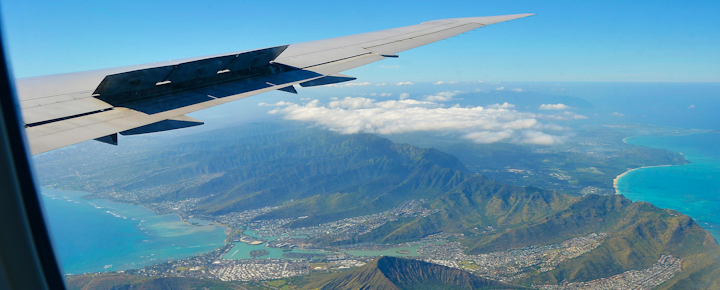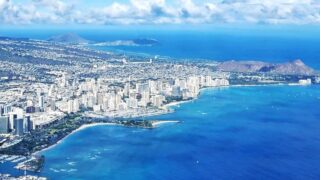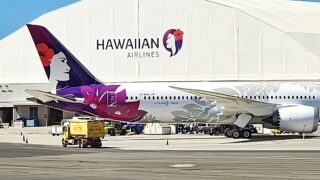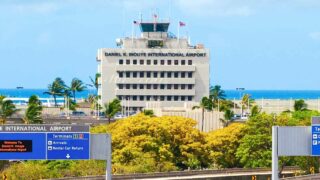Flights to Hawaii are different. Why? These are among the longest overwater flights in the world (without a diversion point), with more than 2,500 miles of open ocean separating the islands from North America. It means that you could at any point be up to three hours from the nearest diversion airport. For a multitude of reasons, safety takes on a new meaning.
Did you know that the FAA once said they would never allow flights to Hawaii on today’s twin-engine aircraft?
“It’ll be a cold day in hell before I let twins fly long-haul over-water routes,” said FAA Administrator Lynn Helms in 1980 when asked by Boeing to approve longer duration ETOPS. If you don’t know ETOPS, we’ll share more in today’s post. It is critical that an aircraft can fly with one engine across the Pacific, even when it is three hours away from land. For Hawaii flights, that requires what’s known as ETOPS-180 certification.
How much Hawaii aviation has changed.
It’s interesting how much has changed since the FAA said “no way.” We barely noticed that with the advent of these longer-duration twin-engine Hawaii flights, 4-engine jets largely disappeared. There’s only one Hawaii flight that uses an A380 four-engine plane, and that is on ANA from Japan, which resumed last month. The last time either of us flew to or from Hawaii on a plane with more than two engines was in the 1990s on a Qantas 747-400 flight from Australia.
Mid-Pacific Hawaii Aircraft Diversions.
Aircraft diversions are always an unwanted experience, albeit sometimes necessary for technical, medical, or other safety reasons. They are of far greater concern when it comes to Hawaii fights. While we may not think about it often, the issue is real.
Do you remember UAL fight 724? The plane from Honolulu to San Francisco had to divert back to Honolulu when the crew realized they would not have enough fuel to complete the flight. UAL said the flight “encountered strong headwinds [and] out of an overabundance of caution, turned back about two hours…”
When flying to or from Hawaii, or anywhere over long stretches of ocean, diversions become a far greater concern than flying over land. There are simply no diversion options between Hawaii and the U.S. Mainland. Thus, consideration is solely based on the feasibility of either returning to Hawaii or continuing to the west coast. The distance between Hawaii and the west coast represents the longest span without a diversion point in the Pacific.
How ETOPS changed everything.
It’s a term most of us are familiar with but rarely think about its meaning. You’ll recall that Southwest had to obtain its ETOPS certification, including proving flights to fly to the islands. It involved equipment, procedures, and personnel. ETOPS means extended operations (or extended-range twin-engine operational performance standards to be technical). It is a series of measures designed to provide greater safety when flying over water and in other areas where there are few if any diversion airports in the event of an emergency. These were developed in the 1980s and apply perfectly to Hawaii flights.
Alternate airports are calculated for each flight and represent places where the plane can land in the event of any in-flight issues. Sometimes a flight might divert to a different island or a different west coast city that’s closer, for example.
180-minute ETOPS is what’s needed for Hawaii flights.
As aircraft engines and other systems have become ever more reliable, more rules were developed to let twin-engine aircraft operate further afield, like to the islands. We still remember when the first 737s were allowed to fly to Hawaii. Traveling more than 2500 miles in a relatively small plane seemed unheard of.
Then in 2002, Hawaiian Airlines acquired fuel-efficient twin-engine Boeing 767s to replace all of its prior fuel-guzzling three-engine DC10s. They became the first airline to ever receive 180-minute ETOPS certification at that time, without having any prior ETOPS experience.
When flying between the U.S. and Europe, for example, 120-minute ETOPS is typically what’s required. That means 2 hours flying on one engine. But that also isn’t adequate when it comes to Hawaii and other trans-pacific routes. For Hawaii and other places in the Pacific, 180-minute ETOPS is needed. For each additional level of certification, it becomes more stringent and costly to obtain and retain approval.
What is the history of allowing twin-engine planes to fly to Hawaii?
Since we’re trusting our lives to these systems, it’s good to know more about them. We did a lot of checking to bring this to you and knowing we have a lot of aviation aficionados here, we look forward to your additions and corrections.
Twin-engine ETOPS began in the mid-80s when the first 767 was allowed to fly between the U.S. and France. That was using ETOPS-120 (120 minutes from land). But as long ago as 1953, the U.S. developed regulations prohibiting both two and three-engine aircraft from routes more than 60-minutes landing time away. But that was even before jet travel, and we’ve come a long way since then. The next step was ETOPS-90, then ETOPS-120, and ETOPS-180. It’s been a process, and in the beginning, planes had to achieve a problem-free year at ETOPS-120 before completing 180. But that’s no longer the case.
Long ago, L-1011 and DC-10 tri-jets started plying the Pacific. It took until the late 1980s for that rule to be waived, paving the way for twin-engine planes. In 1988, ETOPS-180 became available, subject to the strictest regulations and qualifications. The first plane so certified was the Boeing 777. By 1990, Boeing and the FAA agreed that a plane’s entry into service could commence with ETOPS-180.
Boeing 767 was the proving aircraft for today’s Hawaii flights.
The 767, flying trans-Atlantic in the 1980s, became proof of the reliability of ETOPS. Then in 1989, ETOPS-180 made Hawaii flights possible and the first such ETOPS 767 flight was on American Airlines from Dallas to Honolulu. The rest is history, as the 767 was followed by the 777 and the A330 fleets, which still fly to Hawaii today.
Aloha Airlines was the first airline to operate a 737 ETOPS-180 to Hawaii.
That was back in 2000, using their Boeing 737-700 aircraft. That opened the door to today’s Hawaii routes that are still dominated by these smaller twin-engine jets including Boeing 737 and Airbus A32x variants.
Get Breaking Hawaii Travel News







Aloha Gents, not sure how I got from jelly fish to ETOPS, but point of interest; some years back I was researching ETOPS and came across an FAA study of B767 transatlantic engine shutdowns, all makes, per 100,000 flight hours. I don’t recall the exact number, but it was so small that I was left with the distinct impression that “these engines just don’t fail”. They do fail, of course, but I would say, on a statistical basis, they fail rarely.
Mahalo
Hi Gerry.
Thanks for that.
Aloha.
I believe that the scheduled airline flights between Mauritius and Perth, Australia are not about 1000 miles longer over ocean than the Hawaii to California flights without any available alternate airport.
I believe the A350XWB has ETOPS certification for ETOPS-370.
Earth is flat.
No if and or buts about it.
So actually Korean airlines flies the 747-8 still for passenger traffic to Hawaii. Not just Ana with the a380
Thank you for this overview on the evolution of 2-engine flights to Hawaii. Good technical aviation info. I grew up with the 747 from Hawaii to the mainland; was nervous when 2-engines became the only option. Now I’m fine with them, but only when they are the larger 767s and A330s. Still won’t fly the tiny 737s. That’s like flying in a sardine can.
Hi Carol.
Thank you. Who wouldn’t rather fly in a wide body? But when it comes down to connections with that or narrow-body nonstop, we’ll take the 737.
Aloha.
Well let’s give an “A”, to the genius who figured out Hawaii destinations have the longest flights over the water. God Bless our public education system.
It was known to be the longest overwater route from the first days of air travel. In fact, PanAm had to have planes made in order to make it from San Francisco to Honolulu without stopping, the seaplanes of the 1920s and ’30s. Because from Hawaii, doing the island hop to Midway, Wake, etc, the times in the air were not as long.
Our Hawaiian Air flight in July from Sydney to Honolulu had a medical emergency onboard. We were 3000 miles from Sydney and 2000 miles to Honolulu. The specks of islands on the flight map were likely not able to accommodate the plane. Poor lady looked DRT but she was given oxygen by the flight attendants. There was one passenger who came forward as either a Dr, nurse or EMT. I felt so bad for the husband. They looked like they were nearly 80. It was a worst nightmare I’m sure. We hope she is ok. There wasn’t an ambulance waiting for us in Honolulu so maybe she was fine after a while. I would be afraid to fly home if she were Australian. Kudos to the flight attendants too cause they stayed by her side and didn’t freak out. Very professional!
ETOPS: Engines Turn Or Passengers Swim. Or, Engines Turn Or Planes Sinks.
Aloha! The segment from the west coast to (near) Hawaii is all water. From that point on to SYD (or anywhere else South of the equator) there are many diversion airports dotted along the way.
What about LAX to SYD? Wouldn’t that be the longest overwater flight?
All I know is my Alaska Air flight from SEA to HON was a nightmare! Supposedly didn’t hold enough fuel to make it to Honolulu, so we had to fly 180 miles south to Portland to upload extra fuel. Then we bounced our way across the Pacific…seatbelt sign on the whole way. Took us 8 hours, so we landed about 11pm instead of 9pm. I will never fly AK again! Instead fly wide body Hawaiian yearly.
They had severe head winds nothing to do with the airline! I’ve been flying for 33 years across the pond and had that happen twice. Different airlines. Ridiculous to think it was the airline. Widebody aircraft won’t make any difference…
It is a long flight, but has multiple alternate airports along the way, until the portion that equates to Hawaii to California.
An interesting addition to the part about Aloha becoming a 737 ETOPS-180 operator. Aloha actually had ETOPS certification at before, which it worked off of when going for their -180 certification in 1999-2000. The reason, why AQ had (I believe it was -120) certification, was because they operated the only 737-200 with ETOPS certification in the world. Their flights to Christmas Island were done in modified -200s, where you could tell long-range antennas were installed and stretched between the tail and the fuselage.
Hi Stan.
Ah good point. They used to fly to the Cook Islands, but not to Christmas Island, which is in the Indian Ocean NW of Australia.
Aloha.
Aloha guys, there’s more than one Christmas Island and AQ definitely flew there. 🙂
Hi Mark.
Thanks. We appreciate that. They did fly to the other Christmas Island.
Aloha.